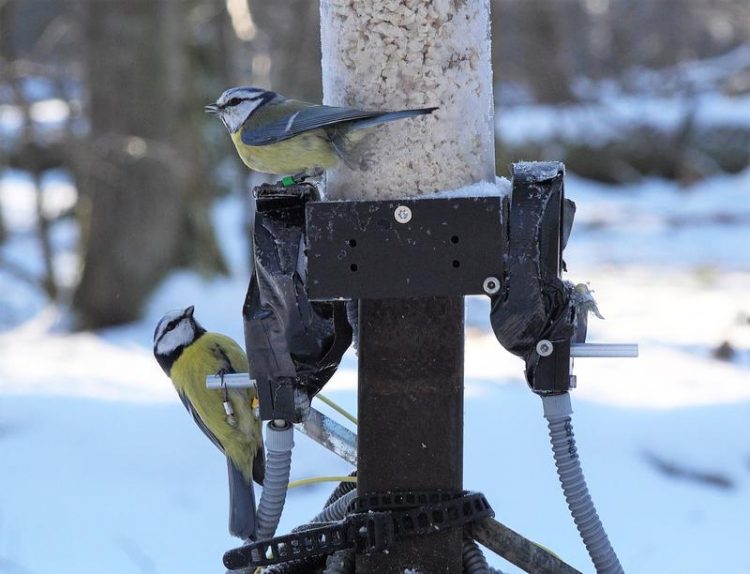Social networks reveal dating in blue tits

Blue tits that often foraged together during winter were more likely to end up as breeding pairs or as extra-pair partners in spring. Kristina Beck
Many socially monogamous bird species engage in sexual behaviour outside their pair bond, often resulting in extra-pair young. However, despite decades of research, the ability to explain who will have extra-pair young with whom is limited.
Researchers of the Max Planck Institute for Ornithology and the Max Planck Institute for Animal Behaviour now examined whether social associations prior to the breeding season influenced patterns of social and extra-pair mating.
They studied blue tits that typically form socially monogamous pairs, but frequently engage in extra-pair mating.
About half of all nests contain at least one young with a genetic father other than the social one, and up to 15% of all offspring are sired by extra-pair males.
During winter, blue tits forage in large mixed-species flocks where they potentially already meet future mating partners.
The researchers quantified the birds’ social associations during foraging events at local bird feeders and while visiting nest-boxes during winter.
To obtain these data, they installed a self-designed, custom-built automated monitoring system including 20 feeders and 277 nest-boxes in their forest study site in Southern Germany.
Blue tits in the study area carried a tiny “Passive Integrated Transponder” (PIT-tag) with an individual code activated externally by the scanning device in the feeder or nest-box.
With this setup, the researchers could record the date, time, and identity of every PIT-tagged blue tit visiting. Using these data the researchers created a social network that visualizes who hangs out with whom and how often.
They found that 39% of the birds present in the study site in winter bred in the subsequent spring. Nearly all social breeding pairs were formed by the individuals present during winter and those that foraged more often together were also more likely to end up as breeding pairs.
The social network analysis further shows that individuals that are more strongly associated during winter tend to nest closer together.
Most extra-pair sires are close neighbours
“As most extra-pair sires are close neighbours, one could think that extra-pair paternity in blue tits might simply be the result of coincidental meetings between neighbours, and not a social preference for specific mating partners,” says Kristina Beck, first-author of the study.
However, the analysis shows that mating patterns can be explained by the strong social association itself: males and females foraging together and those that co-inspected nest-boxes were more likely to have extra-pair young together in the subsequent breeding season.
The researchers also found temporal changes in the social network: social bonds between future breeding partners seem to be established earlier in winter than those between future extra-pair partners.
Bart Kempenaers, leading the study, adds: “When and how individuals make mating decisions is still largely unknown. However, our research provides new insights into the dynamics of different types of social relationships. Our work shows that extra-pair mating often happens between individuals that already know each other”.
Kristina Beck
Doctoral Student
Department of Behavioural Ecology and Evolutionary Genetics
Max Planck Institute for Ornithology, Seewiesen
Phone: ++49 (0)8157 932-231
E-mail: kbeck@orn.mpg.de
Prof. Dr. Bart Kempenaers
Director
Department of Behavioural Ecology and Evolutionary Genetics
Max Planck Institute for Ornithology, Seewiesen
Email: b.kempenaers@orn.mpg.de
Beck KB, Farine DR, Kempenaers B. 2020 Winter associations predict social and extra-pair mating patterns in a wild songbird. Proc. R. Soc. B 20192626.
http://dx.doi.org/10.1098/rspb.2019.2606
http://www.orn.mpg.de/4531878/news_publication_14488308_transferred?c=2732
Media Contact
All latest news from the category: Life Sciences and Chemistry
Articles and reports from the Life Sciences and chemistry area deal with applied and basic research into modern biology, chemistry and human medicine.
Valuable information can be found on a range of life sciences fields including bacteriology, biochemistry, bionics, bioinformatics, biophysics, biotechnology, genetics, geobotany, human biology, marine biology, microbiology, molecular biology, cellular biology, zoology, bioinorganic chemistry, microchemistry and environmental chemistry.
Newest articles

First-of-its-kind study uses remote sensing to monitor plastic debris in rivers and lakes
Remote sensing creates a cost-effective solution to monitoring plastic pollution. A first-of-its-kind study from researchers at the University of Minnesota Twin Cities shows how remote sensing can help monitor and…

Laser-based artificial neuron mimics nerve cell functions at lightning speed
With a processing speed a billion times faster than nature, chip-based laser neuron could help advance AI tasks such as pattern recognition and sequence prediction. Researchers have developed a laser-based…

Optimising the processing of plastic waste
Just one look in the yellow bin reveals a colourful jumble of different types of plastic. However, the purer and more uniform plastic waste is, the easier it is to…



